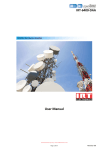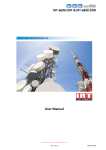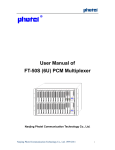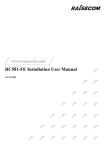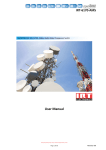Download IRT-6170-AAS User Manual (Revision 00)
Transcript
IRT-6170-AAS Dual 4x1 / Single 7x1 Analogue Stereo / Digital Audio Relay Switcher User Manual IRT Electronics Pty Ltd | www.irtelectronics.com Page 1 of 20 Revision 00 IRT-6170-AAS Dual 4x1 / Single 7x1 Analogue Stereo / Digital Audio Relay Switcher Revision History: Revision 00 Date 21/05/2014 By AL Change Description Original Issue. Applicable to: Firmware ≥ Revision 3.0 IRT Electronics Pty Ltd | www.irtelectronics.com Page 2 of 20 Revision 00 IRT-6170-AAS USER MANUAL Table of Contents: Section Page Revision History Operational Safety openGear® Introduction General Description Technical Specifications Configuration DIP Switch Settings Installation Signal Connections Front Edge Switch Locations Rear Assembly Layout Remote Rear Assembly Wiring HE-14 Connector Pin Assignments 15-pin D-Connector Pin Assignments 9-pin RS-232 D-Connector Pin Assignments Operation Interconnecting Switchers Remote Control IRT-RC1 IRT-RP1 DashBoard™ Software Control IRT-6170-AAS DashBoard™ Screenshots SNMP Software Control IRT-6170-AAS SNMP Functions Maintenance & Storage Warranty & Service 2 4 4 5 6 7 7 8 8 9 10 11 11 11 12 13 13 14 14 15 16 16 19 19 20 20 This instruction book applies to units fitted with firmware ≥ Revision 3.0. IRT Electronics Pty Ltd | www.irtelectronics.com Page 3 of 20 Revision 00 IRT-6170-AAS OPERATIONAL SAFETY WARNING Operation of electronic equipment involves the use of voltages and currents that may be dangerous to human life. Note that under certain conditions dangerous potentials may exist in some circuits when power controls are in the OFF position. Maintenance personnel should observe all safety regulations. Do not make any adjustments inside equipment with power ON unless proper precautions are observed. All internal adjustments should only be made by suitably qualified personnel. All operational adjustments are available externally without the need for removing covers or use of extender cards. openGear® INTRODUCTION Developed by Ross Video, openGear® is a standard where various manufacturers can design their equipment to fit a common frame allowing the end user to mix and match the various openGear® cards available in the market place together in one frame. This allows a single frame to be used instead of multiple different vendor’s frames that each would otherwise be using their own proprietary standard. A simple to use monitoring and control software called DashBoard™ is a free program downloadable from the openGear® website (www.opengear.tv) that allows the user to remotely monitor and control an openGear® type card fitted within an openGear® frame that meets the openGear® standard for DashBoard™ control. A link is also supplied via the IRT Electronics website (www.irtelectronics.com) under the openGear® navigation section. IRT Electronics’ openGear® cards are designed to meet the openGear® standard for mounting within the openGear® OG3-FR frame and its earlier version DFR-8300 frame, and is fully compliant with DashBoard™ control. The openGear® frame manual, DashBoard™ control software and information regarding the frame’s power supplies, controller card and frame accessories are available for download at the openGear® website. The term openGear® is a registered trade mark of Ross Video Limited. DashBoard software Control™ is a trade mark of Ross Video Limited. IRT Electronics Pty Ltd | www.irtelectronics.com Page 4 of 20 Revision 00 IRT-6170-AAS GENERAL DESCRIPTION BLOCK DIAGRAM IRT-6170-AAS SIGNAL PATH Audio I/P 1 Audio I/P 2 Audio I/P 3 Audio I/P 4 Audio I/P 5 Audio I/P 6 Audio I/P 7 Audio I/P 8 4x1 STEREO or Balanced SWITCHER Audio O/P 1 4x1 STEREO or Balanced SWITCHER Audio O/P 2 REMOTE CONTROL DASHBOARD The IRT-6170-AAS analogue stereo / digital audio switcher is part of a family of IRT openGear® switchers that may be linked and configured by the user to cover a wide range of switching and monitoring functions. On board links allow the switcher to be configured for either dual 4x1 or single 7x1 operation. The switcher may be slaved to operate in conjunction with similar switchers for analogue and digital video and audio signals. This makes the switchers ideally suited to situations where a mixture of analogue and digital signals are present. Optionally remote control is via a momentary wire per crosspoint (WPX) control connector allowing interface to the IRT-RC1 remote control panel or a telemetry system, or alternatively via an RS232 remote. The IRT-6170-AAS is designed to fit the openGear® standard 2RU frames which allow a mixture of cards from various manufacturers to be mounted within the same frame. The DashBoard™ control software is available as a free download. Standard features: • Dual 4 x 1 or single 7 x 1 relay switch. • Stereo or Balanced Inputs & Outputs. • Latching relays. • Optional Remote Control. • DashBoard™ software monitoring and control. IRT Electronics Pty Ltd | www.irtelectronics.com Page 5 of 20 Revision 00 IRT-6170-AAS TECHNICAL SPECIFICATIONS Audio inputs: Number Type Audio Crosstalk 8 Balanced Audio or Balanced AES); or 4 Stereo pair (Left and Right). Latching Relay. < -90 dB (20 Hz - 20 kHz, input terminated by 600 Ω). Audio outputs: Type Number Latching Relay. 2 (left and right or Balanced Audio or Balanced AES). Control: Type 1 Momentary wire per crosspoint (WPX) grounding contacts . Type 2 openGear® DashBoard™ software. Type 3 RS-232 (9600bps, 8 data bits, No parity, 1 Stop bit, No flow control). Connectors: Balanced Control (with remote option) Phoenix 3 terminal plug-in blocks. Plug in 10 pin HE14 dual IDC, DB9 or DB15. Power Requirements: Voltage Power consumption + 12 Vdc. < 1.5 VA. 1 1 Other: Temperature range 0 - 50° C ambient. Mechanical Suitable for mounting in an openGear® 2RU rack chassis. Dimensions (openGear® standard) 33.6 mm x 2U x 325 mm. Supplied accessories Rear connector assembly. Ordering Standard, programmed with DashBoard™ and SNMP control. Optional double width rear assembly with remote control interfaces. 1 Optional remote control panel with 8 pushbuttons & tally LED’s. Optional 1RU 19” rack mounting plate for IRT-RC1 remote control panel. IRT-6170-AAS IRT-6170-ARC IRT-RC1 IRT-RP1 NOTE: 1 IRT-6170-ARC double width rear assembly required for connection to IRT-RC1, WPX and RS-232 control lines. Due to our policy of continuing development, these specifications are subject to change without notice. IRT Electronics Pty Ltd | www.irtelectronics.com Page 6 of 20 Revision 00 IRT-6170-AAS CONFIGURATION DIP Switch settings: DIP ON DIP SW1 ON 1 2 3 4 5 6 7 8 Switcher mode: SW1-1 OFF ON Dual Switcher follow SW1-2 OFF (Stereo Mode) ON 1 2 3 4 5 6 7 8 SW2 Dual 4x1 mode. 2 Single 7x1 mode. In dual mode, switchers operate independently. In dual mode, each switcher follows the other regardless of which switcher’s control line is activated – Stereo mode.. SW1-3 Not Used. SW1-4 Not Used. SW1-5 Not Used. SW1-6 Not Used. SW1-7 Not Used. Remote Switch Delay SW1-8 OFF ON No delay in switching with IRT-RC1 or WPX control line input. IRT-RC1 remote push-button (or WPX input) must be held for approximately 2 seconds before switching takes place so as to prevent switching if a switch is accidentally bumped. SW2-1 Not Used. SW2-2 Not Used. SW2-3 Not Used. SW2-4 Not Used. SW2-5 Not Used. SW2-6 Not Used. SW2-7 Not Used. SW2-8 Not Used. NOTE: 2 To operate in 7x1 mode, OUT-A must be connected to IN-B4 by an external cable. IRT Electronics Pty Ltd | www.irtelectronics.com Page 7 of 20 Revision 00 IRT-6170-AAS INSTALLATION Pre-installation: Handling: This equipment may contain or be connected to static sensitive devices and proper static free handling precautions should be observed. Where individual circuit cards are stored, they should be placed in antistatic bags. Proper antistatic procedures should be followed when inserting or removing cards from these bags. Installation in openGear® frame: See details in separate manual downloadable from the openGear® website (www.opengear.tv). Signal Connections: Signal connections are made to 3-pin Phoenix style screw connectors. No termination of inputs is provided on the module. When switched to the output the input load impedance is that of the load connected to the output, usually high impedance (HI-Z). When IRT-6170-AAS switcher is set up for dual 4x1 mode, IN-A1 to INA4 are switched, when selected, to OUT-A; and IN-B1 to IN-B4 are switched, when selected, to OUT-B. This mode is for a 4x1 balanced audio switcher application. For 7x1 operation OUT-A must be connected to IN-B4 by an external cable. When selected, inputs IN-A1 to IN-B3 are switched to OUT-B. It is not possible as a 7x1 balanced stereo switcher except when operating in parallel with a second switcher. It is possible, however, for a 7x1 unbalanced stereo switcher where both unbalanced audio signals share the common 3-pin connector where the ground connections are both connected to the ground (G) pin. Single 7x1 Dual 4x1 + G + G G + G OUT-B OUT-A IN 4 + + IN 7 G IN-B4 IN-A4 + G + IN 6 G IN-B3 IN-A3 IN 3 + G + IN 5 G IN-B2 IN-A2 + Switcher 2 (Right) G IN-B1 IN-A1 + G IN 2 + G OUT-B OUT-A + G + G IN-B4 IN-A4 G IN 1 + G IN-B3 IN-A3 Switcher 1 + (Left) + G IN-B2 IN-A2 + G IN-B1 IN-A1 + G + OUT G IRT Electronics Pty Ltd | www.irtelectronics.com Page 8 of 20 Revision 00 IRT-6170-AAS Front Edge Switch Locations Green/Red LED: GREEN – Communication with frame’s Network card. RED - No communication with Network card / No Network card. Front Edge Indicators: In this situation switcher is in default dual 4x1 mode with both IN-A1 and IN-B1 switched to their respective outputs OUT-A and OUT-B as indicated by the illuminated LEDs. IN-A1 IN-A2 IN-A3 IN-A4 IN-B1 IN-B2 IN-B3 IN-B4 IRT-6170-AAS SW_boot switch: Default Reset Switch. User set names and switch position are stored within memory so that in the event of a loss of power this information is restored on resumption of power. If the default Reset Switch is pressed whilst powering or inserting the card, the IRT-6170-AVS will default to factory preset names and input position. IRT Electronics Pty Ltd | www.irtelectronics.com Page 9 of 20 Revision 00 IRT-6170-AAS Rear Assembly Layout Wire per crosspoint (WPX) interfaces for IRT-RC1 remote control panel (1:1 pin-pin wiring). Only 10 pin HE-14 or 15 pin D-connector need be used, not both RS-232 interface. Standard Rear Assembly Remote Control Rear Assembly (IRT-6170-ARC) IRT Electronics Pty Ltd | www.irtelectronics.com Page 10 of 20 Revision 00 IRT-6170-AAS Remote Rear Assembly Wiring: The IRT-6170-AAS is supplied with its own standard rear assembly. Only 3-pin Phoenix style signal inputs and outputs are fitted. Control of the IRT-6170-AAS is only via DashBoard™ or SNMP software controls. For remote control and monitoring via pushbutton switches, a remote panel, IRT-RC1, is available. This requires the IRT-6170-ARC double width rear assembly to replace the standard rear assembly of the IRT-6170-AAS switcher. IRT-RC1 is connected via either the 10-pin HE-14 style header or via the 15-pin D-connector. Cable wiring is 1:1 pin-pin. Note that the HE-14 pin connections are wired in parallel with the D15 connector pins. Although both are provided, only one connector need be wired to the optional IRT-RC1 panel. Wire per crosspoint (WPX) control by an external source is also possible via the 10-pin HE-14 style header or the 15-pin D-connector. RS-232 control is also possible via the 9-pin D-connector. HE-14 Connector Pin Assignments: On the remote rear assembly a 10-pin HE-14 style of connector is used for pin to pin connection to the 10-pin HE-14 style of connector of the optional IRT-RC1 remote panel. The pins are momentary wire per crosspoint (WPX) control lines and can also be used with an external momentary switch to ground telemetry system. The +3.3Vdc power is for powering the LEDs of the remote panel. +3.3Vdc Power REMOTE 1 REMOTE 3 REMOTE 5 REMOTE 7 1 2 3 4 5 6 7 8 9 10 GND REMOTE 2 REMOTE 4 REMOTE 6 REMOTE 8 REMOTE 15-pin D-Connector Pin Assignments: On the remote rear assembly a 15-pin D-connector (female) style of connector is used for pin to pin connection to the 15-pin D-connector (female) style of connector of the optional IRT-RC1 remote panel. The pins are momentary wire per crosspoint (WPX) control lines and can also be used with an external momentary switch to ground telemetry system. The +3.3Vdc power is for powering the LEDs of the remote panel. The Remote RS-232 Tx and Rx pins are not used with the IRT-RC1 remote control panel and do not need to be wired, though no issues will occur if they are. PIN 1 2 3 4 5 6 7 8 9 10 11 12 13 14 15 - REMOTE 1 - REMOTE 2 - REMOTE 3 - REMOTE 4 - REMOTE 5 - REMOTE 6 - REMOTE 7 - REMOTE 8 - +3.3Vdc Power - GND - Not Connected - Not Connected - Not Connected - RS-232 Tx - RS-232 Rx IRT Electronics Pty Ltd | www.irtelectronics.com Page 11 of 20 Revision 00 IRT-6170-AAS 9-pin RS-232 D-Connector Pin Assignments: On the remote rear assembly a 9-pin RS-232 D-connector (female) connector is used for pin to pin connection to a 9-pin RS-232 computer control port. PIN 1 2 3 4 5 6 7 8 9 NOTE: 3 - N/C - RS232 RX - RS232 TX - N/C - GND - N/C - N/C - N/C 3 - 3.3Vdc External Power 3.3Vdc external power provided by resistor link RLK on underside of rear assembly for IRT RS232 remote panel. If not required, or is likely to be shorted to ground through interconnect cable, do not wire pin 9 or remove RLK. IRT Electronics Pty Ltd | www.irtelectronics.com Page 12 of 20 Revision 00 IRT-6170-AAS OPERATION Being a relay switcher, the IRT-6170-AAS can be used as a dual 4x1 independent, dual 4x1 ganged (Stereo), or 7x1 switcher suitable for signals such as balanced analogue audio or balanced digital audio (AES). Unbalanced audio can also be wired either between the ground (G) and positive (+) pins or between the ground (G) and negative (-) pins of the 3-pin Phoenix style connectors. Unbalanced stereo can be wired to the same connector where one channel is connected between the ground (G) and positive (+) pins and the other channel is connected between the ground (G) and negative (-) pins – the ground connectors sharing the common ground (G) pin. IN-A1 IN-A2 IN-A3 Switcher control is done remotely by DashBoard™ or SNMP software control, or by external signals connected via either the 10-pin HE-14 type of control connector or the 15-pin D-connector on the optional dual width IRT-6170-AAS rear assembly. IN-A4 IN-B1 IN-B2 IN-B3 When in the dual 4x1 mode the upper four LEDs indicate inputs IN-A1 to IN-A4 of the first 4x1 switcher that feed Output A, whilst the lower four LEDs indicate inputs IN-B1 to IN-B4 of the second 4x1 switcher that feed Output B. IN-B4 When in the Single 7x1 mode only the upper seven LEDs will illuminate corresponding to the selected input (IN-A1, IN-A2, IN-A3, IN-A4, IN-B1, IN-B2 or IN-B3) that feed Output B. Output A must be connected to IN-B4 by an external BNC cable for single 7x1 operation. IRT-6170-AAS Front edge LEDs illuminate to indicate which input has been selected. Interconnecting Switchers: It is possible to daisy chain switchers’ control lines together as a Master-Slave pair for situations where the control of one switcher automatically controls others in the chain, such as switching audio following video or digital video following analogue video, etc. In order to interconnect switchers, each type of switcher must be fitted to it’s corresponding dual width remote rear assembly. Either the 10-pin HE-14 remote control connectors or the 15-pin D-connectors can be cascaded together to create a common control bus. Note that the HE-14 connector is paralleled with the first 10 pins of the 15-pin D-connector, so it does not matter whether one rear assembly’s HE-14 connector is connected to a neighbouring rear assembly’s HE-14 remote connector or its 15-pin D-connector. IRT Electronics Pty Ltd | www.irtelectronics.com Page 13 of 20 Revision 00 IRT-6170-AAS Remote Control: Remote control of the IRT-6170-AAS is possible via three ways: 1. Software Control via DashBoard™ or SNMP (see separate sections); 2. Wire per crosspoint (WPX) via grounding contacts to either an external telemetry system, or to an IRT-RC1 remote control panel with 8 pushbuttons & tally LED’s; 3. RS-232 remote control (not described). IRT-RC1: The IRT-RC1 remote panel is an 8 button remote control panel that allows pushbutton control to the IRT-6170-AAS. The push-buttons illuminate green when pressed to indicate the selected input and mirror that of the IRT-6170-AAS front edge indicators and the DashBoard™ software control. In order to use the IRT-RC1 remote control panel the IRT-6170-AAS requires the remote control double width rear assembly (IRT-6170-ARC). Two connectors are provided for connection to the rear assembly - either the 10 pin blue HE-14 type of connector wired pin for pin, or a female D15 connector wired pin for pin (pins 1 to 10 need only be connected) – only one connector need be used, not both unless connecting to a master or slave switcher, such as the IRT-6170-AVS video relay switcher for audio follows video applications, or to more IRT-RC1 remote control panels to allow parallel control from multiple locations where IRT-RC1 remote control panels are interconnected. When switching with the IRT-RC1 remote control panel, push-button should be pressed and held for approximately half a second. However, if the switcher delay setting has been set by DIP switch SW1-8 = ON, then the IRT-RC1 pushbuttons need to be held for approximately 2 seconds. The IRT-RC1 front panel is designed to be mounted within the IRT-RP1 remote panel mount 19” 1RU panel for control desk or rack applications, though it will also mount in a standard 3RU Eurocard type of frame. IRT Electronics Pty Ltd | www.irtelectronics.com Page 14 of 20 Revision 00 IRT-6170-AAS IRT-RP1: The IRT-RP1 is a 1RU 19” rack mount panel allowing up to three IRT remote panels to be mounted within a control desk or 19” rack. IRT-RP1 fitted with an IRT-RC1 remote control panel IRT Electronics Pty Ltd | www.irtelectronics.com Page 15 of 20 Revision 00 IRT-6170-AAS DashBoard™ SOFTWARE CONTROL The DashBoard™ Control and Monitoring System is a free application designed for remote control and monitoring of the openGear® platform. This is a free application downloadable from the openGear® website (www.opengear.tv). As such, configuration of the DashBoard™ program will not be described here. The DashBoard™ manual is also downloadable from the openGear® website. IRT-6170-AAS DashBoard™ Screenshots: Basic Tree View: On the left the basic tree view shows the frame. With the tree structure expanded a list of cards within the frame is shown. In this example, slot position 2 is highlighted. All sections and tabs to the right of the basic tree view now relate to the card in slot position 2, in this case the IRT-6170-AAS Analogue Stereo / Digital Audio Relay Switcher. The name of the switcher, in this case Relay Switch, can be set under the Configuration TAB setting. Product TAB: Self explanatory. Note that the Product Alias field can be set under the Configuration TAB setting. Note that the Product field is labelled as “IRT-6170-AAS/AVS”. This is because both the IRT-6170-AAS and IRT-6170-AVS both use the same type of main board that is programmed the same. It is the rear assembly that sets these two product types apart. IRT Electronics Pty Ltd | www.irtelectronics.com Page 16 of 20 Revision 00 IRT-6170-AAS Dipswitch Settings TAB: The Dipswitch TAB shows whether the switcher has been set up for Dual 4x1 Mono (SW1-1 = OFF + SW1-2 = OFF), Dual 4x1 Stereo (SW1-1 = OFF + SW1-2 = ON), or Single 7x1 (SW1-1 = ON); and whether the two second delay for remote switching is disabled (SW1-8 = OFF) or enabled (SW1-8 = ON). Config TAB: Under the Configuration TAB parameters such as Product Alias (name) and Input Aliases (names) can be user set. Click computer mouse into the field to change and type new name. SNMP Traps can also be enabled via this TAB. IRT Electronics Pty Ltd | www.irtelectronics.com Page 17 of 20 Revision 00 IRT-6170-AAS Outputs TAB: Under this TAB, monitoring and control of the switcher state takes place. Switcher control is by clicking on an input name with a computer mouse. The output names correspond to the relevant switched input names. If switcher has been configured for Dual 4x1 Stereo mode (SW1-1 = OFF + SW1-2 = ON), clicking on an input name, IN-A4 for example, will cause the corresponding input of the second switcher, in this case IN-B4, to automatically follow. The same holds true for A if one of the B inputs were clicked on. If the switcher has been configured for Single 7x1 mode, then only inputs IN-A1 to IN-B3 and Output B parameters are shown. IRT Electronics Pty Ltd | www.irtelectronics.com Page 18 of 20 Revision 00 IRT-6170-AAS SNMP SOFTWARE CONTROL Control via SNMP is possible via a third party Network Management System (NMS) provided the openGear® frame is fitted with a relevant Network Management card. In the case of the OG3-FR frame the MFC-8322-NS network management card is required for SNMP control. In the case of either the DFR-8310 or DFR-8321 frames either the MFC-8310-NS or MFC-8320-NS cards are required for SNMP control. Relevant frame MIBs and card MIB required to interface to NMS software - see IRT Electronics website (www.irtelectronics.com) for MIB download. IRT-6170-AAS SNMP Functions: The following SNMP functions are capable of being controlled and monitored by an NMS: productAlias - An indication of the Alias (Name) of this card (as set by DashBoard™). boardRev - An indication of the hardware (board) revision of this card. switcherMode - An indication of the Switcher Mode setting as per the PCB DIP switch SW1-1 & SW1-2 settings. (0) Dual4x1Mono: Card set up as two separate independent 4x1 switchers. (1) Dual4x1Stereo: Card set up as two 4x1 switchers that follow each other. (2) Single7x1: Card set up as a single 7x1 switcher. rearAssembly - An indication whether the card is inserted into the correct rear assembly or not. (1) match: Card is inserted into correct rear assembly. (2) mismatch: Card is inserted into incorrect rear assembly. outASetting - An indication of the control of the input being switched to Output A. (0) IN-A1: IN-A1 switched to Output A. (1) IN-A2: IN-A2 switched to Output A. (2) IN-A3: IN-A3 switched to Output A. (3) IN-A4: IN-A4 switched to Output A. (4) notApplicable: Not Applicable – reported when switcher set up as Single 7x1 mode. outAName - An indication of the name of the input being switched to Output A (as set by DashBoard™). outBSetting - An indication of the control of the input being switched to Output B. (0) IN-A1: IN-A1 switched to Output B. (1) IN-A2: IN-A2 switched to Output B. (2) IN-A3: IN-A3 switched to Output B. (3) IN-A4: IN-A4 switched to Output B. (4) IN-B1: IN-B1 switched to Output B. (5) IN-B2: IN-B2 switched to Output B. (6) IN-B3: IN-B3 switched to Output B. (7) IN-B4: IN-B4 switched to Output B. outBName - An indication of the name of the input being switched to Output B (as set by DashBoard™). snmpTrapEnable - An indication and control of whether Traps have been enabled. (0) disable: Traps are disabled. (1) enable: Trap automatically sent if card plugged into wrong rear assembly or a change of switcher state occurs. IRT Electronics Pty Ltd | www.irtelectronics.com Page 19 of 20 Revision 00 IRT-6170-AAS MAINTENANCE & STORAGE Maintenance: No regular maintenance is required. Care however should be taken to ensure that all connectors are kept clean and free from contamination of any kind. This is especially important in fibre optic equipment where cleanliness of optical connections is critical to performance. Storage: If the equipment is not to be used for an extended period, it is recommended the whole unit be placed in a sealed plastic bag to prevent dust contamination. In areas of high humidity a suitably sized bag of silica gel should be included to deter corrosion. Where individual circuit cards are stored, they should be placed in antistatic bags. Proper antistatic procedures should be followed when inserting or removing cards from these bags. WARRANTY & SERVICE Equipment is covered by a limited warranty period of three years from date of first delivery unless contrary conditions apply under a particular contract of supply. For situations when “No Fault Found” for repairs, a minimum charge of 1 hour’s labour, at IRT’s current labour charge rate, will apply, whether the equipment is within the warranty period or not. Equipment warranty is limited to faults attributable to defects in original design or manufacture. Warranty on components shall be extended by IRT only to the extent obtainable from the component supplier. Equipment return: Before arranging service, ensure that the fault is in the unit to be serviced and not in associated equipment. If possible, confirm this by substitution. Before returning equipment contact should be made with IRT or your local agent to determine whether the equipment can be serviced in the field or should be returned for repair. The equipment should be properly packed for return observing antistatic procedures. The following information should accompany the unit to be returned: 1. 2. 3. 4. 5. 6. 7. A fault report should be included indicating the nature of the fault The operating conditions under which the fault initially occurred. Any additional information, which may be of assistance in fault location and remedy. A contact name and telephone and fax numbers. Details of payment method for items not covered by warranty. Full return address. For situations when “No Fault Found” for repairs, a minimum charge of 1 hour’s labour will apply, whether the equipment is within the warranty period or not. Contact IRT for current hourly rate. Please note that all freight charges are the responsibility of the customer. The equipment should be returned to the agent who originally supplied the equipment or, where this is not possible, to IRT directly. Details of IRT’s direct address can be found at IRT Electronics’ website. Web address: www.irtelectronics.com Email: [email protected] IRT Electronics Pty Ltd | www.irtelectronics.com Page 20 of 20 Revision 00






















